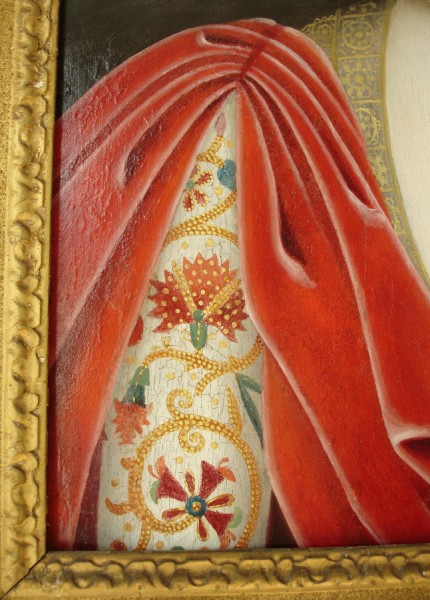 A visit to Parham House in Sussex has just reminded me of the wonderful embroideries on display there. They have an impressive collection of stumpwork pictures, as well as tapestries and furnishings. Parham House has a generous attitude to photography, allowing photos provided no flash is used. What a boon for anyone who enjoys the History of English Embroidery – it means you can look at the images in more detail than you can get in a postcard. As well as embroideries, there are some fantastic examples shown in portraits. I love the way the artist has captured the texture of the velvet, shown in the top photo, and the way the pile captures the light. It is quite amazing that although so few actual examples of Elizabethan embroideries still exist, we have such a good idea of what they looked like through portraits. This is such a good example, showing gold-work and silk shaded fantasy flowers in the swirling designs that the Elizabethans loved so much.
A visit to Parham House in Sussex has just reminded me of the wonderful embroideries on display there. They have an impressive collection of stumpwork pictures, as well as tapestries and furnishings. Parham House has a generous attitude to photography, allowing photos provided no flash is used. What a boon for anyone who enjoys the History of English Embroidery – it means you can look at the images in more detail than you can get in a postcard. As well as embroideries, there are some fantastic examples shown in portraits. I love the way the artist has captured the texture of the velvet, shown in the top photo, and the way the pile captures the light. It is quite amazing that although so few actual examples of Elizabethan embroideries still exist, we have such a good idea of what they looked like through portraits. This is such a good example, showing gold-work and silk shaded fantasy flowers in the swirling designs that the Elizabethans loved so much.
The one above is said to be of Elizabeth I, although art historians question this as the shape of her face is different from other portraits of her. Anyway, whoever she is, just look at the detail in the starched Reticella lace collar, and the mad little silk-worms embroidered on her dress.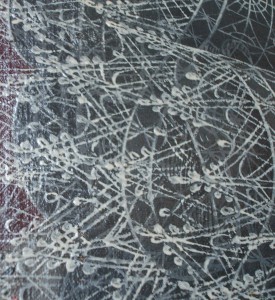
This poor soul looks like she could be quite spirited, if she could only move her head!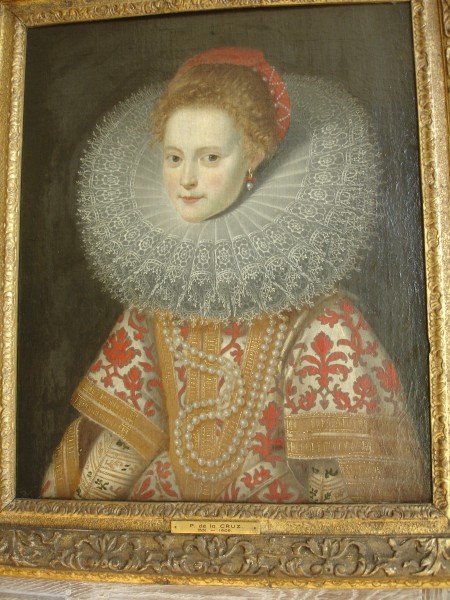
A question for you
Now, I have a question. As part of the City and Guilds Diploma in Stitched Textiles (Embroidery), everyone does a big project on The History of English Embroidery. I loved doing mine; I got completely engrossed in it, and it ran to 100 A3 pages. I would rather not know how long it actually took! Now after all that work it is shut away in a cupboard, which seems abit of a waste. When I was doing it I came across some fantastic books written by specialists in their field which tended to be on very specific areas, such as a particular technique or an era. I found relatively few that had a complete overview (except for the wonderful book by Lanto Synge that includes the whole of Western Europe). What I was also looking for was something that was relatively short and simple, and contained more of a summary that would give an ‘overview’ before delving into the more rarefied professional tomes. Then when we had our C&G end of course show I noticed that other C&G students wanted to photograph pages from our finished projects, as a starting point for their own project. So I wonder if there’s any interest in me putting it all on the website so that anyone who is interested can see it? It’s no substitute for studying the specialist books by the professional textile historians (or preferably seeing the originals) but it may be useful as a starting-point.
I’d need to scan it page by page, so I thought I’d see first if there’s any interest. What do you think?





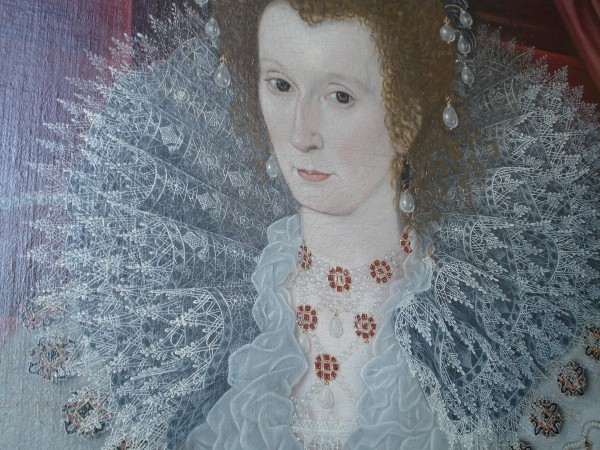
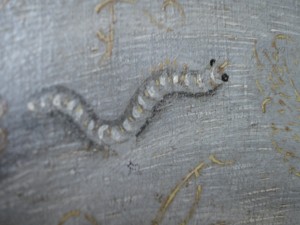
Hi Jane
I am doing the C and G Diploma this year with Janet and would certainly love to see your project again as we didn’t have time to look at all the folders you had done.
Lorna
Hi Lorna,
Thanks for the feedback. There may be a delay before I can get this done, as I’m moving house soon. There will be several months of chaos, but I hope to catch up on things like that once we’ve settled in.
I hope you enjoy the course – you must be starting soon.
Best wishes,
Jane.
Thanks Jane,
We have our first meeting for the Diploma on Oct 14. There are five of us who did the certificate and have decided to carry on, although now we have seen the homework Janet has sent us to do, I’m wondering whether the theme of pagodas that I’ve chosen I can achieve the high standard that you and the others seem to have achieved but I’m going to give it my best shot.
Good luck with the move.
Lorna
Hi Lorna,
Pagodas sound interesting. Generally people choose subjects that end up being too broad and then narrow them down later, but you would probably avoid that. If you happened to choose somewhere like China or Japan for one of your 3 countries then there could be an interesting overlap. I visited a wonderful pagoda in Nepal that was made from carved wood, which had wonderful shapes textures in the carvings.
The main thing is just to get absorbed in the subject. Janet has probably advised you do do abit of drawing over the summer, and I’d also really encourage you to do a few sketches between now and October if you’ve got time. I wouldn’t worry about where it will take you – that’s the joy of it, it’s an adventure. And I wouldn’t try to compare your work now with the work you see at the end of Diploma course shows. I nearly didn’t sign on for the original Certificate course for that reason. It’s an unfair comparison, as you will develop so many new skills and ideas that you couldn’t predict at the beginning. Do keep us posted, and have fun!